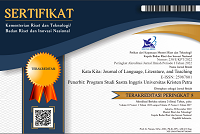COMMON ERRORS FOUND IN THE USE OF SENTENCE STRUCTURE: A CASE STUDY
DOI:
https://doi.org/10.9744/katakita.4.1.13-17Abstract
This study is done to find out: (1) the common errors in the use of sentence structure and (2) the similarities and differences on the types of errors in the use of sentence structure between original draft in the first topic, second topic, and third topic of Written English 4B class English Department in Petra Christian University. The writer chooses the theory of common errors in the use of sentence structure as proposed by Ho (2005). The findings of this study show that there are seven (7) out of eight (8) types of errors that occur in the students’ drafts. Fragmented Sentence is the most common error made by the students in their drafts. In addition, there were similarities and differences on the types of errors and the frequency of occurrences of errors among the students. In conclusion, most of the students have understood about the use of sentence structure.
References
Batsone, R. (1995). Grammar. New York: Oxford University Press.
Dörnyei, Z. (2007). Research methods in applied linguistics: Quantitative, qualitative, and mixed methodologies. Oxford: Oxford University Press.
Ellis, R. (1997). Second language acquisition. Oxford: Oxford University Press.
Ho, C. M. L. (2005). Sentence structure. In Exploring errors in grammar (Second ed.). Singapore: Pearson Education South Asia Pte..
Hogan, G. (2012). Writing an essay. In Building Better Paragraphs (1st ed., pp. 201-202). Cengage Learning.
Littlewood, W. (1984). Foreign and second language learning: language acquisition research and its implications for the classroom. New York: Cambridge University Press.
Richards, J., Platt, J., & Weber, H. (1985). Longman dictionary of applied linguistic (p. 95, p. 284). Burnt Mill: Longman.
Richards, J., & Schmidt, R. (2010). Longman dictionary of applied linguistic (4th ed., pp. 522-523). Longman: Pearson education limited.
Downloads
Issue
Section
License
Authors who publish with this journal agree to the following terms:- Authors retain copyright and grant the journal right of first publication with the work simultaneously licensed under a Creative Commons Attribution License that allows others to share the work with an acknowledgement of the work's authorship and initial publication in this journal.
- Authors are able to enter into separate, additional contractual arrangements for the non-exclusive distribution of the journal's published version of the work (e.g., post it to an institutional repository or publish it in a book), with an acknowledgement of its initial publication in this journal.
- Authors are permitted and encouraged to post their work online (e.g., in institutional repositories or on their website) prior to and during the submission process, as it can lead to productive exchanges, as well as earlier and greater citation of published work (See The Effect of Open Access).














